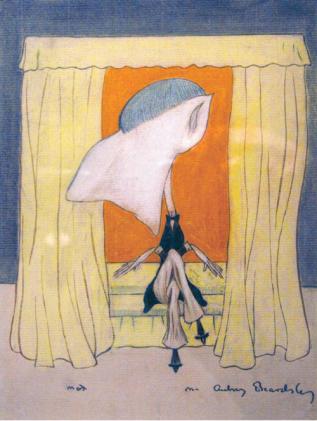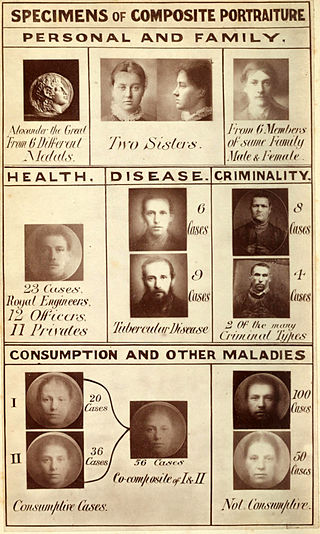
ASCII art is a graphic design technique that uses computers for presentation and consists of pictures pieced together from the 95 printable characters defined by the ASCII Standard from 1963 and ASCII compliant character sets with proprietary extended characters. The term is also loosely used to refer to text-based visual art in general. ASCII art can be created with any text editor, and is often used with free-form languages. Most examples of ASCII art require a fixed-width font such as Courier for presentation.
Computer vision tasks include methods for acquiring, processing, analyzing and understanding digital images, and extraction of high-dimensional data from the real world in order to produce numerical or symbolic information, e.g. in the forms of decisions. Understanding in this context means the transformation of visual images into descriptions of the world that make sense to thought processes and can elicit appropriate action. This image understanding can be seen as the disentangling of symbolic information from image data using models constructed with the aid of geometry, physics, statistics, and learning theory.

Pattern recognition is the automated recognition of patterns and regularities in data. While similar, pattern recognition (PR) is not to be confused with pattern machines (PM) which may possess (PR) capabilities but their primary function is to distinguish and create emergent pattern. PR has applications in statistical data analysis, signal processing, image analysis, information retrieval, bioinformatics, data compression, computer graphics and machine learning. Pattern recognition has its origins in statistics and engineering; some modern approaches to pattern recognition include the use of machine learning, due to the increased availability of big data and a new abundance of processing power.

Digital art refers to any artistic work or practice that uses digital technology as part of the creative or presentation process. It can also refer to computational art that uses and engages with digital media.

A caricature is a rendered image showing the features of its subject in a simplified or exaggerated way through sketching, pencil strokes, or other artistic drawings. Caricatures can be either insulting or complimentary, and can serve a political purpose, be drawn solely for entertainment, or for a combination of both. Caricatures of politicians are commonly used in editorial cartoons, while caricatures of movie stars are often found in entertainment magazines.
Lillian F. Schwartz is an American artist considered a pioneer of computer-mediated art and one of the first artists notable for basing almost her entire oeuvre on computational media. Many of her ground-breaking projects were done in the 1960s and 1970s, well before the desktop computer revolution made computer hardware and software widely available to artists.

Thomas Shi-Tao Huang was a Chinese-born American computer scientist, electrical engineer, and writer. He was a researcher and professor emeritus at the University of Illinois at Urbana-Champaign (UIUC). Huang was one of the leading figures in computer vision, pattern recognition and human computer interaction.
Kenneth Charles Knowlton was an American computer graphics pioneer, artist, mosaicist and portraitist. In 1963, while working at Bell Labs, he developed the BEFLIX programming language for creating bitmap computer-produced movies. In 1966, also at Bell Labs, he and Leon Harmon created the computer artwork Computer Nude .

In the field of photographic imaging, a photographic mosaic, also known under the term Photomosaic, is a picture that has been divided into tiled sections, each of which is replaced with another photograph that matches the target photo. When viewed at low magnifications, the individual pixels appear as the primary image, while close examination reveals that the image is in fact made up of many hundreds or thousands of smaller images. Most of the time they are a computer-created type of montage.
Deborah Hay is an American choreographer, dancer, dance theorist, and author working in the field of experimental postmodern dance. She is one of the original founders of the Judson Dance Theater. Hay's signature slow and minimal dance style was informed by a trip to Japan while touring with Merce Cunningham's company in 1964. In Japan she encountered Noh theatre and soon incorporated nô's extreme slowness, minimalism and suspension into her post-Cunningham choreography. Sometimes she also imposed stressful conditions on the dancers, as with her "Solo" group dance that was presentation at 9 Evenings: Theatre and Engineering.

Computer graphics is a sub-field of computer science which studies methods for digitally synthesizing and manipulating visual content. Although the term often refers to the study of three-dimensional computer graphics, it also encompasses two-dimensional graphics and image processing.

Visual perception is the ability to interpret the surrounding environment through photopic vision, color vision, scotopic vision, and mesopic vision, using light in the visible spectrum reflected by objects in the environment. This is different from visual acuity, which refers to how clearly a person sees. A person can have problems with visual perceptual processing even if they have 20/20 vision.

Lorinda Cherry was an American computer scientist and programmer. Much of her career was spent at Bell Labs, where she was for many years a member of the original Unix Lab. Cherry developed several mathematical tools and utilities for text formatting and analysis, and influenced the creation of others.

2.5D is an effect in visual perception. It is the construction of an apparently three-dimensional environment from 2D retinal projections. While the result is technically 2D, it allows for the illusion of depth. It is easier for the eye to discern the distance between two items than the depth of a single object in the view field. Computers can use 2.5D to make images of human faces look lifelike.
ISO/IEC 19794 Information technology—Biometric data interchange formats—Part 5: Face image data, or ISO/IEC 19794-5 for short, is the fifth of 8 parts of the ISO/IEC standard ISO/IEC 19794, published in 2005, which describes interchange formats for several types of biometric data. ISO/IEC 19794-5 defines specifically a standard scheme for codifying data describing human faces within a CBEFF-compliant data structure, for use in facial recognition systems. Modern biometric passport photos should comply with this standard. Many organizations and have already started enforcing its directives, and several software applications have been created to automatically test compliance to the specifications.
The history of computer animation began as early as the 1940s and 1950s, when people began to experiment with computer graphics – most notably by John Whitney. It was only by the early 1960s when digital computers had become widely established, that new avenues for innovative computer graphics blossomed. Initially, uses were mainly for scientific, engineering and other research purposes, but artistic experimentation began to make its appearance by the mid-1960s – most notably by Dr Thomas Calvert. By the mid-1970s, many such efforts were beginning to enter into public media. Much computer graphics at this time involved 2-dimensional imagery, though increasingly as computer power improved, efforts to achieve 3-dimensional realism became the emphasis. By the late 1980s, photo-realistic 3D was beginning to appear in film movies, and by mid-1990s had developed to the point where 3D animation could be used for entire feature film production.

Lincoln in Dalivision is a 1977 original limited edition lithograph created by Salvador Dalí. It is often considered one of the most counterfeited Dalí lithographs. Dalí authentication experts who have noted the counterfeiting issue with this work include Albert Field, Frank Hunter, Robert Descharnes and Bernard Ewell. Lee Catterall comments in his book The Great Dalí Art Fraud & other deceptions, "The painting most commonly reproduced for such fraudulent purposes was Lincoln in Dalivision, 'prints' of which Los Angeles art appraiser Dena Hall testified in the Hawaii trial have become as commonplace as 'pancakes at the pancake house.'"

Composite portraiture is a technique invented by Sir Francis Galton in the 1880s after a suggestion by Herbert Spencer for registering photographs of human faces on the two eyes to create an "average" photograph of all those in the photographed group.

William Fetter, also known as William Alan Fetter or Bill Fetter, was an American graphic designer and pioneer in the field of computer graphics. He explored the perspective fundamentals of computer animation of a human figure from 1960 on and was the first to create a human figure as a 3D model. The First Man was a pilot in a short 1964 computer animation, also known as Boeing Man and now as Boeman by the Boeing company. Fetter preferred the term "Human Figure" for the pilot. In 1960, working in a team supervised by Verne Hudson, he helped coin the term Computer graphics. He was art director at the Boeing Company in Wichita.

Theodosios Pavlidis is a computer scientist and Distinguished Professor Emeritus of Computer Science at the State University of New York, Stony Brook.













